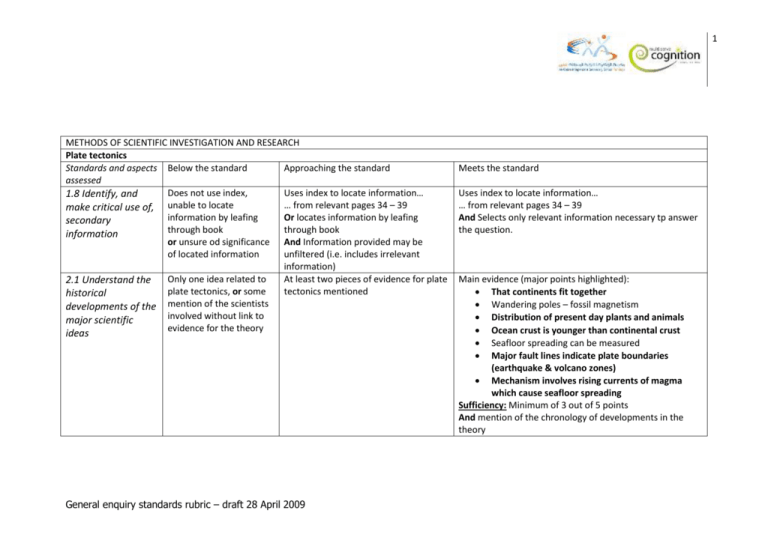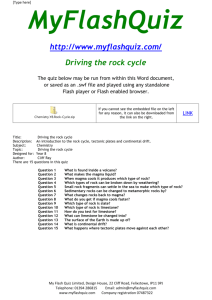completed rubrics for geology tasks
advertisement

1 METHODS OF SCIENTIFIC INVESTIGATION AND RESEARCH Plate tectonics Standards and aspects Below the standard Approaching the standard assessed Does not use index, Uses index to locate information… 1.8 Identify, and … from relevant pages 34 – 39 make critical use of, unable to locate information by leafing Or locates information by leafing secondary through book through book information or unsure od significance And Information provided may be of located information unfiltered (i.e. includes irrelevant information) Only one idea related to At least two pieces of evidence for plate 2.1 Understand the plate tectonics, or some tectonics mentioned historical developments of the mention of the scientists involved without link to major scientific evidence for the theory ideas General enquiry standards rubric – draft 28 April 2009 Meets the standard Uses index to locate information… … from relevant pages 34 – 39 And Selects only relevant information necessary tp answer the question. Main evidence (major points highlighted): That continents fit together Wandering poles – fossil magnetism Distribution of present day plants and animals Ocean crust is younger than continental crust Seafloor spreading can be measured Major fault lines indicate plate boundaries (earthquake & volcano zones) Mechanism involves rising currents of magma which cause seafloor spreading Sufficiency: Minimum of 3 out of 5 points And mention of the chronology of developments in the theory 2 METHODS OF SCIENTIFIC INVESTIGATION AND RESEARCH ID Limestone Standards and aspects Below the standard assessed Inappropriate or no test is described 1.2 Make predictions and no mention of expected positive directly related to a result research question Approaching the standard Meets the standard The appropriate test is chosen, but student neglects to state that a in positive test gas is evolved. Or a positive result is described and the description of the test is omitted and must be inferred by the reader. The test involves adding acid to the sample and watching for bubbles/fizzing if the sample contains carbonate. 3.1 Record raw data appropriately in a manner that allows easy interpretation Incorrect or insufficient information in observations column 3.3 Draw valid conclusions, allowing for errors and uncertainties Either C or D not correctly identified as limestone. If samples A & B had been contaminated with carbonate powder they might fizz with acid. C & D must be correctly identified. 4.1 Select and use correctly and competently the appropriate equipment and materials for an investigation, with due regard for the safety of self and others One of the questions [Question (describe how you will use…equipment…): And question (describe how you ensured …safety…)] is answered inadequately, or no attempt to answer the questions. Or students behaved in a hazardous way Question (describe how you will use…equipment…): or question (describe how you ensured …safety…) is answered or both questions are answered, but inadequately (information is lacking or superfluous) or students were seen to be conductinf the experiment correctly, with regard for safety. General enquiry standards rubric – draft 28 April 2009 Observations column: A = no fizzing/bubbles/gas B = no fizzing/bubbles/gas C = fizzing/bubbles/gas D = fizzing/bubbles/gas Conclusion column: A= no/not limestone B= no/not limestone C= yes/limestone D= yes/limestone Question (describe how you will use…equipment…)is answered to show evidence that only materials required for adding acid to the sample were used. And question (describe how you ensured …safety…) is answered to show how spillage of acid was minimised by either containment, washing, or wiping of samples, and use of safety glasses by the participants. 3 METHODS OF SCIENTIFIC INVESTIGATION AND RESEARCH Igneous rocks Standards and aspects Below the standard assessed 3.1 Record raw data Omits recording any appropriately in a manner information on one or more that allows easy of the rock samples. interpretation 3.2 Process raw data by the most appropriate means Student unable to use classification chart. 3.3 Draw valid conclusions, allowing for errors and uncertainties One sample only identified correctly. General enquiry standards rubric – draft 28 April 2009 Approaching the standard Meets the standard Some information recorded for each rock type, but some important information is omitted e.g. references to colour but not crystal size Statements refer to a description of the colour and crystal size: 2 = pale, mostly pink, small amount of black, large crystals 3 = more light than dark minerals, no pink, large crystals 7 = mostly dark minerals, large crystals 9 = very pale coloured rock, no visible crystals Igneous rock classification chart is used successfully – i.e. the samples are classified as: Classification chart is used with partial success – i.e… Discussion with student able to resolve issues with using the classification chart. Two or three of the four samples correctly identified. 2 = granite 3 = granodiorite or diorite 7 = basalt or peridotite 9 = rhyolite 4 METHODS OF SCIENTIFIC INVESTIGATION AND RESEARCH Fossils Standards and aspects Below the standard assessed 1.4 Work constructively and Worked individually adaptively with others as a team on a scientific investigation 1.8 Identify, and make Information provided on the critical use of, secondary worksheet is less than that provided information on model answers for approaching the standard. 4.2 Follow instructions accurately but be able to adapt to unforeseen circumstances Has not provided any plausible answer to questions 1, 4 or 8. General enquiry standards rubric – draft 28 April 2009 Approaching the standard Meets the standard Worked cooperatively with one other student to locate information and exchange opinions. Made use of the supplied text and reference sheets to complete the worksheet : For minimum information required, refer to model answers. As for 1.8, and has provided a plausible answer to one of questions 1, 4 and 8 and attempted at least one of the other two questions. Made use of the supplied text and reference sheets to complete the worksheet : For minimum information required, refer to model answers. As for 1.8, and has provided a plausible answer and reason to Questions 1,4 and 8(answers not explicit in text). 5 METHODS OF SCIENTIFIC INVESTIGATION AND RESEARCH Construction rock Standards and aspects Below the standard assessed 1.2 Make predictions directly One application is realistic related to a research question Approaching the standard Meets the standard Two of three applications are realistic All applications of each rock type are realistic, eg: schist = wall construction slate = roofing marble = statues, interior, facings The rock samples are examined and… Information on reverse of sheet is used to make at least one true statement about the properties of schist. Information in the text is used to locate and record at least one true statement about the properties of marble and slate (refer to model answers) Clear descriptive language or drawings used to show how layered nature of slate and schist makes each of these rock types fit for the purpose outlined in 1.8. 1.8 Identify, and make critical use of, secondary information Attempt to say something about the properties of one rock sample only. Information may be false or irrelevant Information is used to make at least one true statement about two of the three rock samples. 3.4 Use an appropriate range of methods to communicate scientific information Information communicated is irrelevant or unscientific. Clear descriptive language or drawings used to show how layered nature of slate or schist makes each of these rock types fit for the purpose outlined in 1.8. Note: Information in the third column in the worksheet – ‘other factors’ is not assessed. The quality of answer here may reflect depth of thinking or student prior knowledge. It may provide data for a further category: ‘Exceeds the standard’ General enquiry standards rubric – draft 28 April 2009 6 General enquiry standards rubric – draft 28 April 2009







